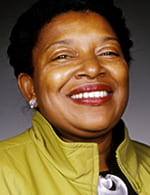
WASHINGTON – The National Endowment for the Arts is racing to keep up with artists who are creating in new formats and for smaller screens, according to speakers at a CCLP forum here on Friday. And that means the agency must prepare to review programs and proposals in new ways.
“One of the challenges all of us face is keeping up with what is going on,” said  Alyce Myatt, NEA’s Director of Media Arts, adding that is due both to the proliferation of formats and to a greater volume of arts being created. But one challenge is the migration to cell phones.
Alyce Myatt, NEA’s Director of Media Arts, adding that is due both to the proliferation of formats and to a greater volume of arts being created. But one challenge is the migration to cell phones.
“It is what is happening now: everyone is on a small screen,” explained Myatt, who said this has implications for artists and for those who fund the arts. “First and foremost they [stories] have to be shorter. So how you make your work either shorter or episodic? There is a skill to that. It can be easier to make a 90-minute documentary than a three-minute story.”
This also means NEA changed the demographics of its reviewers who recommend funding.
“More and more young people are on our panels,” said Patrice Walker Powell, NEA’s Deputy Chairman for Programs and Partnership. Powell added that more and more NEA proposals are “multidisciplinary,” with artists submitting work in multiple formats.
The audience at Friday’s forum were arts editors and reporters from around the country, and some speakers expressed concern about the relationship between arts, art journalism and the community, with personal values identified as a key.
“We all came to arts journalism for different reasons,” said Dan DeVany, Vice President and  General Manager of Washington D.C.’s classical music station, WETA. “I would strongly suggest to you that if you have not done this already, assess your personal values and your relationship with the arts, and define that. It will strengthen you as a writer and a reporter. It will clarify your perspective. What is your role? Having a very clear-cut sense of values is incredibly important.”
General Manager of Washington D.C.’s classical music station, WETA. “I would strongly suggest to you that if you have not done this already, assess your personal values and your relationship with the arts, and define that. It will strengthen you as a writer and a reporter. It will clarify your perspective. What is your role? Having a very clear-cut sense of values is incredibly important.”
Many of the editors and reporters described severe financial pressure on their newsrooms and on arts journalism nationwide, and there was broad agreement that this would hurt not just journalism but the arts themselves.
“There is not a great art city in the world that does not have a great art newspaper,” said Chad Bauman, Associate Executive Director of Washington D.C.’s Arena Stage. Bauman added that his biggest concern was that in an economic downturn, such as the fall, 2008, recession, arts journalism would contract and some outlets could disappear.
DeVany expressed that concern in another way:
“There is a social issue here,” he said. “As an arts reporter with a platform, you are an arts advocate. You represent the arts.”
Friday’s forum was presented by CCLP in partnership with the Association of Alternative Newsmedia.